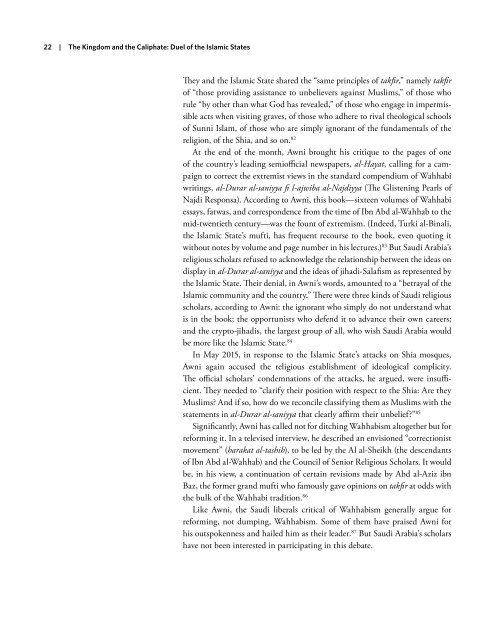Create successful ePaper yourself
Turn your PDF publications into a flip-book with our unique Google optimized e-Paper software.
22 | The Kingdom and the Caliphate: Duel of the Islamic States<br />
They and the Islamic State shared the “same principles of takfir,” namely takfir<br />
of “those providing assistance to unbelievers against Muslims,” of those who<br />
rule “by other than what God has revealed,” of those who engage in impermissible<br />
acts when visiting graves, of those who adhere to rival theological schools<br />
of Sunni Islam, of those who are simply ignorant of the fundamentals of the<br />
religion, of the Shia, and so on. 82<br />
At the end of the month, Awni brought his critique to the pages of one<br />
of the country’s leading semiofficial newspapers, al-Hayat, calling for a campaign<br />
to correct the extremist views in the standard compendium of Wahhabi<br />
writings, al-Durar al-saniyya fi l-ajwiba al-Najdiyya (The Glistening Pearls of<br />
Najdi Responsa). According to Awni, this book—sixteen volumes of Wahhabi<br />
essays, fatwas, and correspondence from the time of Ibn Abd al-Wahhab to the<br />
mid-twentieth century—was the fount of extremism. (Indeed, Turki al-Binali,<br />
the Islamic State’s mufti, has frequent recourse to the book, even quoting it<br />
without notes by volume and page number in his lectures.) 83 But Saudi Arabia’s<br />
religious scholars refused to acknowledge the relationship between the ideas on<br />
display in al-Durar al-saniyya and the ideas of jihadi-Salafism as represented by<br />
the Islamic State. Their denial, in Awni’s words, amounted to a “betrayal of the<br />
Islamic community and the country.” There were three kinds of Saudi religious<br />
scholars, according to Awni: the ignorant who simply do not understand what<br />
is in the book; the opportunists who defend it to advance their own careers;<br />
and the crypto-jihadis, the largest group of all, who wish Saudi Arabia would<br />
be more like the Islamic State. 84<br />
In May 2015, in response to the Islamic State’s attacks on Shia mosques,<br />
Awni again accused the religious establishment of ideological complicity.<br />
The official scholars’ condemnations of the attacks, he argued, were insufficient.<br />
They needed to “clarify their position with respect to the Shia: Are they<br />
Muslims? And if so, how do we reconcile classifying them as Muslims with the<br />
statements in al-Durar al-saniyya that clearly affirm their unbelief?” 85<br />
Significantly, Awni has called not for ditching Wahhabism altogether but for<br />
reforming it. In a televised interview, he described an envisioned “correctionist<br />
movement” (harakat al-tashih), to be led by the Al al-Sheikh (the descendants<br />
of Ibn Abd al-Wahhab) and the Council of Senior Religious Scholars. It would<br />
be, in his view, a continuation of certain revisions made by Abd al-Aziz ibn<br />
Baz, the former grand mufti who famously gave opinions on takfir at odds with<br />
the bulk of the Wahhabi tradition. 86<br />
Like Awni, the Saudi liberals critical of Wahhabism generally argue for<br />
reforming, not dumping, Wahhabism. Some of them have praised Awni for<br />
his outspokenness and hailed him as their leader. 87 But Saudi Arabia’s scholars<br />
have not been interested in participating in this debate.



